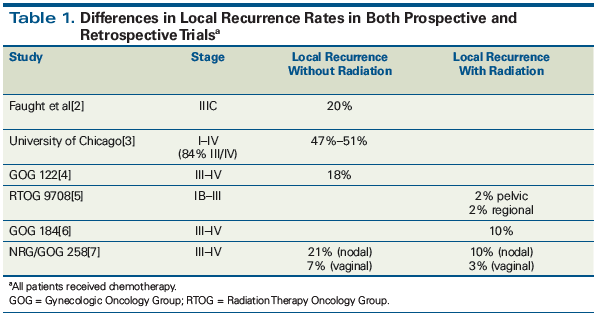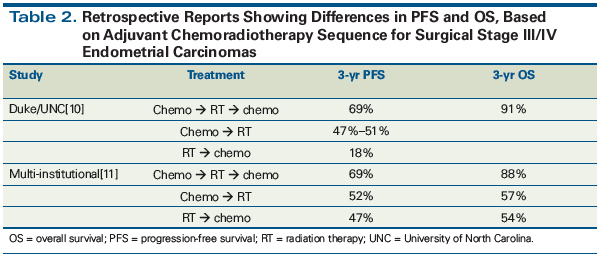POINT: Should Radiation Therapy Be Routinely Used in the Adjuvant Treatment of Stage III Endometrial Cancer?
Adjuvant radiation therapy provides a local control benefit in stage III endometrial carcinoma patients, as strongly suggested in retrospective and prospective series.
Oncology (Williston Park). 32(9):455-8.

Mark E. Bernard, MD

Marcus E. Randall, MD

Table 1. Differences in Local Recurrence Rates in Both Prospective and Retrospective Trials

Table 2. Retrospective Reports Showing Differences in PFS and OS, Based on Adjuvant Chemoradiotherapy Sequence for Surgical Stage III/IV Endometrial Carcinomas

Yes-Radiation Therapy Improves Local Control and Possibly Survival for Some Patients
Despite therapy advances, patients with stage III endometrial carcinoma are at high risk for both distant and local recurrences.[1] Multiagent chemotherapy has been shown to improve progression-free survival (PFS) and overall survival (OS) in some trials.[1] Careful reading of the literature supports the use of adjuvant radiation therapy as well.
High Local Failure Rates With Adjuvant Chemotherapy Alone
Retrospective and prospective reports have shown significant rates of pelvic failure without radiation therapy. Faught et al conducted a review of patients with microscopic stage IIIC endometrioid carcinomas treated with 9 cycles of cyclophosphamide, doxorubicin, and cisplatin.[2] In the 25% of patients who developed recurrences, 80% were limited to the pelvis. The University of Chicago reported on a series of endometrial carcinoma patients, of which 84% were stage III/IV and 49% were stage III.[3] All were treated with 4 to 6 cycles of combination chemotherapy. Approximately 67% of these patients developed recurrences. The pelvic recurrence rate was 47%, and this rate was 51% for lymph node–positive patients. The Gynecologic Oncology Group (GOG) 122 trial was a prospective study of stage III/IVA endometrial carcinoma patients who were randomized to either whole-abdominal radiation therapy or chemotherapy. Although doxorubicin/platinum chemotherapy was associated with higher PFS and OS rates, this arm also had higher rates of initial pelvic failure (18% vs 13%).[4]
Low Local Failure Rates With Adjuvant Radiation Therapy
The Radiation Therapy Oncology Group (RTOG) 9708 trial was a phase II trial showing the feasibility of adjuvant concurrent chemoradiation followed by 4 cycles of doxorubicin/platinum chemotherapy for high-risk (stage IB grade 2 or 3, stage II, and stage III) endometrial carcinoma patients.[5] Stage III patients comprised 61% of the cohort. Pelvic and regional recurrence rates were both 2%, and the distant recurrence rate was 19%. Another trial, GOG 184, prospectively compared 6 cycles of doxorubicin/platinum chemotherapy with or without paclitaxel in patients with surgical stage III/IV endometrial cancer. Both arms received volume-directed radiation therapy. Approximately 88% of patients in each arm had stage III disease, yet only 10% had local recurrences.[6] Table 1 summarizes the different local recurrence rates across trials that either did or did not include adjuvant radiation therapy.
NRG/GOG 258: The Benefit of Radiation Therapy Prospectively Confirmed
NRG/GOG 258 randomized patients with surgical stage III/IV endometrioid cancer and any stage clear cell and serous carcinoma patients to adjuvant chemotherapy with or without concurrent chemoradiation.[7] The chemotherapy-alone arm received 6 cycles of carboplatin and paclitaxel. The experimental arm received volume-directed radiation therapy with cisplatin, followed by 4 cycles of carboplatin and paclitaxel. The primary endpoint was recurrence-free survival (RFS), and the secondary endpoint was OS.
Approximately 96% of patients in each arm were stage III, with the majority having endometrioid histology. At 47 months’ median follow-up, the concurrent chemoradiation arm had a reduction in combined pelvic and para-aortic (10% vs 21%) and vaginal (3% vs 7%) recurrences, but an increase in distant recurrence (28% vs 21%). However, the experimental arm did not show an increase in RFS; the OS data need time to mature.
Incorporating NRG/GOG 258 Results Into Practice
Interim results of NRG/GOG 258 confirmed the local control benefit of radiation therapy, but created additional questions as to how we should clinically incorporate radiation therapy into management, especially given the concern for distant recurrences.
Stage III endometrial carcinoma patients are at a significant risk for both distant and local recurrences. The distant first recurrence rates for the chemotherapy-alone arms in GOG 122, GOG 184, and the Italian Maggi study were 32%, 30%, and 21%, respectively.[4,6,8] The appropriate implementation of adjuvant radiation therapy is associated with fewer local recurrences, which can improve the distant recurrence rates. Theoretically, local recurrence can act as a seed to distant sites of failure, as seen in cervical cancer,[9] providing an additional rationale to optimize local control.
Individualized risk factor assessment may help direct adjuvant therapy. NRG/GOG 258 had a heterogeneous group of stage III carcinoma patients. Approximately 20% were stage IIIA, 5% were stage IIIB, and 70% to 75% were stage IIIC. There were also variations in histologies and grades. Using risk factors that predict for the pattern of recurrence may assist in personalizing adjuvant treatment. Factors such as lymphovascular space invasion, low/moderate grade, and serosal or cervical involvement may predict for a higher risk of local recurrence compared with distant recurrence, and patients with these risk factors may be better served with early radiation in the adjuvant course. Factors predicting for distant recurrence, such as nodal positivity or high grade, could argue for the use of chemotherapy first, with radiation therapy occurring later in adjuvant treatment.
“Sandwich therapy” (a limited number of chemotherapy cycles given first, typically 3 cycles, followed by radiation therapy, and then further cycles of chemotherapy, as tolerated, up to ~6–8 cycles) may be the most appropriate technique to address the competing recurrence risks. Early integration of multiagent chemotherapy can mitigate distant metastasis risk, and incorporation of local radiation within a reasonable time frame will decrease the risk of local recurrence.
Duke University and the University of North Carolina retrospectively reviewed 356 patients with surgical stage III/IV endometrial cancer who received various adjuvant treatments-either chemotherapy alone, radiation alone, or both.[10] Approximately 66% of the patients were stage III. The chemotherapy used consisted mainly of platinum-based triplet regimens. The study showed that combined therapy was associated with better survival than either modality alone. When analyzing the sequence of multimodality therapy, sandwich therapy was associated with the highest PFS and OS rates. A similar multi-institutional retrospective study-of 109 patients treated with different sequences of chemotherapy and radiation-was reported in 2009.[11] Sandwich therapy was associated with an increase in PFS and OS when compared with chemotherapy followed by radiation or vice versa. Table 2 provides a visual summary of these two trials.
Acute toxicity was similar in the two arms of NRG/GOG 258, demonstrating that the addition of radiation should not impact treatment-related morbidity, although the data need to mature before the quality-of-life endpoints can be reported.
Interestingly, PORTEC-3 was a phase III trial that randomized surgically staged high-risk endometrial carcinoma patients (endometrioid type, stage I, grade 3, with deep myometrial invasion and/or lymphovascular space invasion; stage II/III; or stage I–III clear cell) to adjuvant radiation alone or adjuvant concurrent chemoradiation, followed by 4 cycles of doxorubicin/platinum chemotherapy.[12] Overall, the addition of radiation to chemotherapy did not improve OS or failure-free survival (FFS). However, subset analysis did show that combined treatment in stage III disease had a trend of an OS benefit and a significant FFS benefit when compared with adjuvant radiation alone.
Conclusion
Adjuvant radiation therapy provides a local control benefit in stage III endometrial carcinoma patients, as strongly suggested in retrospective and prospective series. The utilization of radiation therapy should be individualized based on surgico-pathologic features. Optimal sequencing of adjuvant therapy may also maximize the benefit of radiation therapy to appropriately address the high risk of both local and distant recurrences.
Financial Disclosure:The authors have no significant financial interest in or other relationship with the manufacturer of any product or provider of any service mentioned in this article.
References:
1. Shah PH, Kudrimoti M, Feddock J, Randall M. Adjuvant treatment for stage IIIC endometrial cancer: options and controversies. Gynecol Oncol. 2011;122:675-83.
2. Faught W, Fung Kee Fung M, Krepart GV, et al. Microscopic surgical stage IIIc endometrioid adenocarcinoma of the endometrium: implications for bimodal adjuvant therapy. Int J Gynecol Cancer. 1998;8:41-5.
3. Mundt AJ, McBride R, Rotmensch J, et al. Significant pelvic recurrence in high-risk pathologic stage I–IV endometrial carcinoma patients after adjuvant chemotherapy alone: implications for adjuvant radiation therapy. Int J Radiat Oncol Biol Phys. 2001;50:1145-53.
4. Randall ME, Filiaci VL, Muss H, et al. Randomized phase III trial of whole-abdominal irradiation versus doxorubicin and cisplatin chemotherapy in advanced endometrial carcinoma: a Gynecologic Oncology Group study. J Clin Oncol. 2006;24:36-44.
5. Greven K, Winter K, Underhill K, et al. Final analysis of RTOG 9708: adjuvant postoperative irradiation combined with cisplatin/paclitaxel chemotherapy following surgery for patients with high-risk endometrial cancer. Gynecol Oncol. 2006;103:155-9.
6. Homesley HD, Filiaci V, Gibbons SK, et al. A randomized phase III trial in advanced endometrial carcinoma of surgery and volume directed radiation followed by cisplatin and doxorubicin with or without paclitaxel: a Gynecologic Oncology Group study. Gynecol Oncol. 2009;112:543-52.
7. Matei D, Filiaci VL, Randall M, et al. A randomized phase III trial of cisplatin and tumor volume directed irradiation followed by carboplatin and paclitaxel vs carboplatin and paclitaxel for optimally debulked, advanced endometrial carcinoma. J Clin Oncol. 2017;35(suppl):abstr 5505.
8. Maggi R, Lissoni A, Spina F, et al. Adjuvant chemotherapy vs radiotherapy in high-risk endometrial carcinoma: results of a randomised trial. Br J Cancer. 2006;95:266-71.
9. Eifel PJ, Winter K, Morris M, et al. Pelvic irradiation with concurrent chemotherapy versus pelvic and para-aortic irradiation for high-risk cervical cancer: an update of Radiation Therapy Oncology Group trial (RTOG) 90-01. J Clin Oncol. 2004;22:872-80.
10. Alvarez Secord A, Havrilesky LJ, Bae-Jump V, et al. The role of multi-modality adjuvant chemotherapy and radiation in women with advanced stage endometrial cancer. Gynecol Oncol. 2007;107:285-91.
11. Secord AA, Havrilesky LJ, O’Malley DM, et al. A multicenter evaluation of sequential multimodality therapy and clinical outcome for the treatment of advanced endometrial cancer. Gynecol Oncol. 2009;114:442-7.
12. de Boer SM, Powell ME, Mileshkin L, et al. Adjuvant chemoradiotherapy versus radiotherapy alone for women with high-risk endometrial cancer (PORTEC-3): final results of an international, open-label, multicentre, randomised, phase 3 trial. Lancet Oncol. 2018;19:295-309.
Newsletter
Stay up to date on recent advances in the multidisciplinary approach to cancer.
